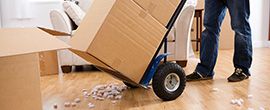Essential Steps to Declutter Before Your Next Move
Posted on 21/05/2025
Essential Steps to Declutter Before Your Next Move
Planning for a move? There's more to it than just packing boxes and hiring movers. Decluttering before moving not only lightens your load but also simplifies the entire process, saving you time, money, and a great deal of stress. Whether you're relocating across town or to a new continent, tackling clutter ensures your move starts on a fresh, organized note.
In this comprehensive guide, we'll walk you through the crucial steps to declutter before your move. You'll learn helpful tips, efficient strategies, and expert advice on how to make your move smoother and more enjoyable.
Why Decluttering Before a Move Matters
Before we dive into the steps to declutter before your next move, it's important to understand why this process is so beneficial:
- Reduces moving costs - Fewer items mean fewer packing materials, reduced truck space, and potentially lower fees from movers.
- Makes unpacking simpler - Arrive at your new home with only what you need and love, making the unpacking process more manageable.
- Cuts down on stress and overwhelm - Fewer possessions mean less to track, organize, and worry about.
- Offers a fresh start - Moving is the perfect opportunity to leave behind items that no longer serve you.
Embracing the decluttering process before moving ensures your new space stays tidy, functional, and filled only with things that add value to your life.

Step 1: Create a Decluttering Plan
The first and essential step to decluttering before moving is developing a solid plan:
- Set a timeline: Start early--ideally, several weeks before your move. Assign specific rooms or areas to each week, keeping your schedule manageable.
- Gather supplies: Stock up on boxes, bags, and bins for sorting items. Don't forget labels and permanent markers!
- Decide on methods: Will you donate, sell, recycle, or toss unwanted items? Choose suitable options for each category.
By outlining what needs to be done and when, you're less likely to feel overwhelmed--and you'll ensure no item gets left behind in the rush.
Step 2: Sort by Category, Not Just by Room
When it comes to the best way to declutter before a move, sorting by category streamlines your efforts:
- Clothing
- Books and papers
- Kitchenware
- Decor and sentimental items
- Electronics and cables
Tackling one category at a time helps you avoid duplication, spot items you rarely use, and make more thoughtful decisions about what to keep.
Step 3: Ask the Right Questions
Sorting items is just the beginning. To effectively declutter before your next move, pause and consider:
- Have I used this in the past year? If not, it's likely time to let it go.
- Is this item broken, expired, or missing parts? If yes, dispose or recycle responsibly.
- Does this really fit in with my lifestyle or my new home?
- Do I own more than one of these? Keep the best, let go of the rest.
- Would I buy this again today? If the answer is no, it's safe to part ways.
These questions cut through emotional attachments and guide you toward rational, mindful decisions--key for decluttering before you move.
Step 4: Use the Four-Box Method
A practical strategy for the decluttering process before moving is the four-box method. Label four boxes as follows:
- Keep - For items you use regularly and will definitely need in your new home.
- Donate - Gently-used items others could benefit from.
- Sell - For valuable items you'd like to convert into cash before the move.
- Trash - Broken, expired, or unusable things.
This hands-on technique streamlines sorting and ensures every item has a clear destination. Don't forget to arrange donation drop-offs, recycling, and trash collection ahead of time!
Step 5: Declutter One Room at a Time
Decluttering room by room helps you focus and keeps the task from becoming overwhelming. Here's a sample order for maximum efficiency:
- Storage spaces: Start with attics, basements, and garages--areas that often collect the most clutter.
- Bedrooms and closets: Wardrobes tend to hold outdated or ill-fitting clothes. Be ruthless--donate or recycle any garment you haven't worn in a year.
- Kitchen: Sort through cabinets, drawers, and the pantry. Dispose of expired food and rarely-used gadgets.
- Living areas: Pare down books, DVDs, decorations, and toys. Get the family involved to speed up the process.
- Bathroom: Safely toss expired medications, old cosmetics, and empty bottles.
By breaking the job down into manageable chunks, you can maintain progress and energy throughout the process.
Step 6: Organize as You Go
Decluttering isn't just about elimination--it's also about organization. As you pare down your belongings:
- Group similar items - Store like with like for easier packing and unpacking.
- Use labels - Clearly mark boxes with contents and destination room.
- Take inventory - Make a list of valuables or essentials for peace of mind during the move.
This step ensures your moving day is as smooth and efficient as possible. An organized move means fewer misplaced items and a stress-free settling-in period at your new place.
Step 7: Sell, Donate, or Dispose Responsibly
With your items organized into categories, it's time to re-home, sell, recycle, or throw them out:
- Selling: Use online platforms (like Facebook Marketplace, Craigslist, or eBay), local consignment shops, or host a garage sale for items in good condition.
- Donating: Many charities, thrift stores, and shelters will accept gently used clothing, furniture, and household goods. Remember to check their guidelines first.
- Disposing: For broken or unusable items, use domestic waste collection, recycling facilities, or hazardous waste disposal services (for items like electronics or paint).
This responsible approach minimizes your environmental impact while giving your belongings a second chance to serve someone else.
Step 8: Declutter Digital Clutter Too
While you're streamlining your physical belongings, don't forget about digital decluttering:
- Back up important files to an external drive or cloud storage.
- Delete unnecessary files, emails, and apps.
- Update contact addresses for subscriptions and essential services.
- Take photos or scans of important documents for extra security.
Decluttering your digital life before moving ensures a fresh start and saves time when setting up in your new place.
Step 9: Prepare an Essentials Box
As moving day approaches, pack a box of must-have items for your first few nights in your new home:
- Toiletries and a few changes of clothing
- Important documents and keys
- Medications, chargers, and basic electronics
- Snacks and basic kitchen items
- Bed linens and a towel for each family member
This ensures you're not frantically searching through boxes after an exhausting moving day.
Step 10: Celebrate and Maintain Your Progress
Once you've completed the steps to declutter before your move, take a moment to appreciate your hard work. Enjoy the sense of lightness and anticipation that comes with shedding unnecessary possessions.
To maintain your clutter-free lifestyle in your new home, follow a few simple guidelines:
- Be mindful of what you bring into your new space--one in, one out is a useful rule.
- Schedule regular mini-decluttering sessions throughout the year.
- Stay organized by designating a home for every item.
This conscious approach helps your new start remain fresh and organized for years to come.
Extra Tips for Stress-Free Decluttering Before a Relocation
- Start early: Procrastination leads to hasty, less effective decluttering. Give yourself plenty of time.
- Get help: Involve family members, or hire professional organizers for large households or tight schedules.
- Avoid the 'maybe' pile trap: Force yourself to make quick decisions rather than letting items linger in indecision.
- Don't buy new storage containers yet: Wait until after decluttering. You'll know exactly what needs organizing (and may need fewer containers than you think!).
- Let go of guilt: It's normal to feel attached, but don't keep things out of guilt or obligation. Your space should serve your current life.

Frequently Asked Questions About Decluttering for a Move
When should I start decluttering before my move?
Ideally, begin decluttering at least one to two months before moving day. This allows time for thoughtful decision-making, listing items for sale, and finding donation drop-off locations. Last-minute decluttering often leads to rushed (and sometimes regretted) decisions.
Should I declutter before or after packing?
Always declutter before packing. This reduces the total amount of stuff you have to move--and saves you money on boxes and moving van space.
What are the best places to donate unwanted items?
Many local charities, thrift shops, shelters, and community organizations accept a wide range of items. National chains like Goodwill and Salvation Army are great options as well. Don't forget local libraries, animal shelters, and domestic violence shelters.
How do I deal with sentimental items?
Be selective. Keep only those that truly bring joy or represent meaningful memories. Consider taking photos of keepsakes to preserve the memory without holding on to the physical item.
Is hiring a professional organizer worth it?
If you're feeling overwhelmed, a decluttering professional can offer unbiased guidance, efficient processes, and emotional support. Especially for large homes or downsizing, professional help can be a valuable investment.
Conclusion: Declutter Before Your Move for a Smoother Transition
The essential steps to declutter before your next move are your ticket to a fresh, organized start in your new space. By following this structured approach--planning, sorting, letting go, and organizing--you'll dramatically simplify the moving process, save money, and enjoy a clutter-free home from day one.
Ready to start decluttering for your upcoming move? Use these tips, honor your progress, and look forward to settling into your new home with only what matters most to you. Happy moving and happy decluttering!






